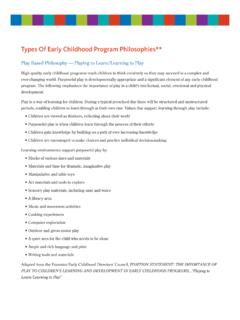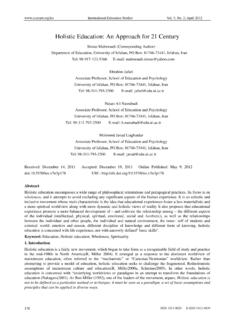Transcription of Pythagoras and Music
1 Pythagoras and Music Melanie Richards, , he musician draws the bow across defined it for centuries a connection T the violin string and immediately the inert atmosphere becomes vibrant and transparent, as if sound from non- with mysticism. Pythagoras the Greek philosopher, initiate, and teacher stood at the point of the marriage of Music , science, spatial realms shines through a window into the and He was one of the first world of space. 1 What is being demonstrated scientists, and as an initiate, he asked deep is a phenomenon known as the overtone series, questions of the universe.
2 In which any tone, played or sung, activates a Traveling to the centers of Babylonia column of mathematically-related notes which and Egypt before settling in southern Italy, vibrate sympathetically with the sounded pitch Pythagoras was likely exposed to ancient and create resonance. Octaves throughout the teachings about the power of number, as universe respond, in a modern, scientific Music well as subjects which sensitized him to ask of the spheres, echoing the hypothesis that dates those important questions. He was known to back to ancient times.
3 Be a person of great knowledge and psychic Until the Industrial Revolution, art, power. Due to his higher nature, legends religion, and science were intertwined; the grew up around him, such as an ability to order of the universe was an ongoing study, travel to celestial realms and actually hear later coming to fruition in the modern the Music of the spheres. The school that he science of astronomy. But in the meantime, founded went on to take his oral teachings to something fell away from science that had even greater heights, influencing every future era of Western civilization.
4 If we ask why Pythagoras 's teachings and discoveries were so far-reaching, we arrive at the beginning point of the law that everything vibrates . a discovery which became a turning-point for a new understanding of the universe. The Discovery of Musical Law Pythagoras 's mind, alive to possibilities, came upon a very simple theorem that had cosmic value. The legend is that Pythagoras , while walking past a blacksmith's shop, heard different pitches being emitted from the striking of the anvils. What is said to have gone through his mind was that the variation in pitches was possibly created by the different weights of the hammers.
5 This story, Rosicrucian possibly symbolically inspired by the legend Gregor Reisch, Arithmetica, from Margarita Digest Philosophia (1504). Pythagoras is on the right. Photo of a magical blacksmith's hammer, may No. 1 by Frank Schulenburg/Wikimedia Commons. have a basis in fact;3 at any rate, Pythagoras 2009. Page 30. authority on Pythagoras and called himself a Pythagorean. In his Manual of Harmonics, he models his explanations of intervals, numbers, and the Music of the spheres on Pythagoras 's teachings as passed down through the years, and it is a good source from which to explain Monochord from the Library of General and some basic Practical Knowledge for Military Candidates Volume 3, 1905.
6 Deutsches Verlaghaus Bong & Co. Berlin. The Pythagoreans found that the speed of vibration and the size of the sound-producing began to experiment with musical overtones body were the factors in Music that were and ratios, which led to one of the most regulated by number. A modern example important discoveries of all time. would be the stringed bass, tuned to the In his search to determine interval ratios lowest notes due to its size. Sound was said in Music (an interval being both the space to be produced by percussion (striking), and the relationship between two sounding followed by a vibration in the air, which was notes), Pythagoras employed the lyre and then received by the ear and carried, in Plato's the monochord, a one-stringed instrument words, to the brain and the blood and he may have invented, which featured frets transmitted to the soul.
7 6 The theory was on the fingerboard at various lengths. By that the vibrational frequency of a stretched stopping the string exactly at the halfway string is inversely proportional to its point, he produced an octave, or a ratio of This basic statement, despite the fact that 1:2. By dividing the string into various other the Pythagoreans had no way of actually lengths, intervals of the fourth and fifth were measuring the vibrations of tones so their produced, and so Pythagoras and his method of assigning numerical values could followers conceived of the universe as a vast not be relied on laid the groundwork for lyre, in which each planet, vibrating at a the development of the science of acoustical specific pitch, in relationships similar to the stopping of the monochord's string.
8 Harmonized with other heavenly bodies to create a Music of the spheres, a concept which remained viable for centuries. Even though his theory was primitive, it serves to give us a picture which was later developed by philosophers such as Boethius, Johannes Kepler, the Rosicrucian Robert Fludd, and, in contemporary times, by scientists working with quantum relationships. The theories set forth by Pythagoras are complex to those uninitiated into mathematical and F. Gafurio, Pythagoras musical analysis, but certain concepts Experimenting with are important to set forth here.
9 Weights on the End of Fixed Length Strings, in Nicomachus of Gerasa, a theorist in Theorica Musice, 1492. the first or second century CE, was an Page 31. physics. By assigning mathematical data as a When the octave was added, the interval basis for harmonious sound, Pythagoras was that was created between the fifth note going against the persuasion of the day that and the octave would be dissonant and pleasing harmony was merely a matter of offensive to Greek ears. Although this theory taste and instinct. is controversial, it is assumed that what Pythagoras did technically was to change The Perfect Octave Creates Harmonia the fifth note by making it a half step higher.
10 Working with his seven-stringed lyre, This caused the two four-note halves of the and thinking of the divisions of the strings scale (known as tetrachords) to be separated that he had discovered, Pythagoras realized by a whole step instead of a half step. This that for the relationships to be complete and action preserved the value of the tetrachords, balanced, the perfect interval of an octave yet created the octave he was looking for. ( , C1-C2) must be part of the existing The original seven-note scale looked like scale. Because he had no way of numerically this:10.









